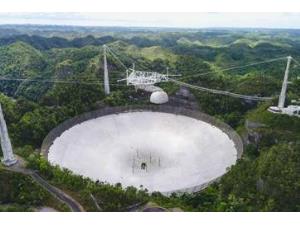



Date:02/12/20
 Sad news came from Puerto Rico. The National Science Foundation (NSF) has decided to decommission the Arecibo radio telescope and disassemble it.
Sad news came from Puerto Rico. The National Science Foundation (NSF) has decided to decommission the Arecibo radio telescope and disassemble it.
Experts came to the conclusion that the telescope is critically bad, and attempts to repair it may result in the collapse of the structures.
The Arecibo radio telescope has been in operation for 57 years and, prior to the commissioning of the FAST radio telescope, was considered the world's largest filled aperture radio telescope.
The telescope consists of a spherical antenna with a 305 meters diameter, located in a sinkhole.
The structure also has a 900-ton mobile platform with a feed, suspended at a height of 137 meters above the antenna using 18 metal cables connected to three concrete towers.
In August of this year, one of the auxiliary metal cables slipped out of the socket, punching a hole in the antenna and damaging a number of elements of the telescope
Then, in November, one of the main cables supporting the metal platform above the telescope snapped, causing further damage.
Inspection of the telescope revealed new breaks in individual strands on the other main cables, as well as instability of the auxiliary cables in their nests.
Several firms hired to review the observatory's condition have concluded that repairs to the telescope would be unsafe for engineers and could cause the platform to collapse onto the antenna.
As a result, it was decided to stop the operations of the telescope and begin preparations for its controlled demolition.
In the near future will begin the development of a plan for the decommissioning of the telescope, as well as for taking pictures of the telescope using drones.
The specialists intend to preserve the observatory's lidar as a valuable tool for geospatial research, as well as a weather station and a visitor center.
During its work, the telescope made a huge contribution to science. It helped to discover the PSR B1257 + 12 pulsar, around which the first known exoplanets orbit.
The observatory recorded fast radio bursts and conducted radar observations of a number of asteroids approaching the Earth, and in 1974 the telescope sent the famous Arecibo message to the globular star cluster M13.
The radiotelescope also appeared in films like Golden Eye and Contact.
Arecibo radio telescope will be decommissioned
 Sad news came from Puerto Rico. The National Science Foundation (NSF) has decided to decommission the Arecibo radio telescope and disassemble it.
Sad news came from Puerto Rico. The National Science Foundation (NSF) has decided to decommission the Arecibo radio telescope and disassemble it.Experts came to the conclusion that the telescope is critically bad, and attempts to repair it may result in the collapse of the structures.
The Arecibo radio telescope has been in operation for 57 years and, prior to the commissioning of the FAST radio telescope, was considered the world's largest filled aperture radio telescope.
The telescope consists of a spherical antenna with a 305 meters diameter, located in a sinkhole.
The structure also has a 900-ton mobile platform with a feed, suspended at a height of 137 meters above the antenna using 18 metal cables connected to three concrete towers.
In August of this year, one of the auxiliary metal cables slipped out of the socket, punching a hole in the antenna and damaging a number of elements of the telescope
Then, in November, one of the main cables supporting the metal platform above the telescope snapped, causing further damage.
Inspection of the telescope revealed new breaks in individual strands on the other main cables, as well as instability of the auxiliary cables in their nests.
Several firms hired to review the observatory's condition have concluded that repairs to the telescope would be unsafe for engineers and could cause the platform to collapse onto the antenna.
As a result, it was decided to stop the operations of the telescope and begin preparations for its controlled demolition.
In the near future will begin the development of a plan for the decommissioning of the telescope, as well as for taking pictures of the telescope using drones.
The specialists intend to preserve the observatory's lidar as a valuable tool for geospatial research, as well as a weather station and a visitor center.
During its work, the telescope made a huge contribution to science. It helped to discover the PSR B1257 + 12 pulsar, around which the first known exoplanets orbit.
The observatory recorded fast radio bursts and conducted radar observations of a number of asteroids approaching the Earth, and in 1974 the telescope sent the famous Arecibo message to the globular star cluster M13.
The radiotelescope also appeared in films like Golden Eye and Contact.
Views: 337
©ictnews.az. All rights reserved.Similar news
- Azerbaijani project to monitor disease via mobile phones
- Innovative educational system to be improved under presidential decree
- NTRC prolongs license of two TV and radio organizations for 6 years
- Azerbaijan establishes e-registry for medicines
- Azerbaijani museum introduces e-guide
- Nar Mobile opens “Nar Dunyasi” sales and service center in Siyazan city
- International conference on custom electronic services held in Baku
- OIC secretary general to attend COMSTECH meeting in Baku
- Azerbaijan develops earthquake warning system
- New law to regulate transition to digital broadcasting in Azerbaijan
- Azerbaijani State Social Protection Fund introduces electronic digital signature
- Intellectual traffic management system in Baku to be commissioned in December
- Tax Ministry of Azerbaijan started receiving video-addresses
- World Bank recommends Azerbaijan to speed up e-service introduction in real estate
- Azerbaijan to shift to electronic registration of real estate





















